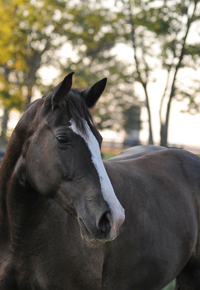When you’re in the midst of juggling training schedules, equitation pointers, and snacking needs, it’s easy to forget certain critical elements of managing Humans: their gear. I recently had a training breakthrough in which The Biped upgraded our jumping saddle from a secondhand bargain basement find to a French-made masterpiece.
I wish I could say this was a result of the numerous catalogues and promotional emails I started signing her up for the day I saw the used Monstrosity, but alas, I think she just took the recommendation of a fellow Human. She is so easily swayed by peer pressure. I assume that explains the haircut, which doesn’t look nearly as good on her as it did on Alexis Bledel.
ADVERTISEMENT
The trial process for this new beauty put me in mind of the best way to test saddle fit. Remember that once you settle into a new saddle, you’re probably stuck with it unless your rider is a professional with a sponsorship deal, or independently wealthy. Be as thorough as possible when scoping out the new item, and don’t forget that the saddle must fit your Biped as well as yourself.
- When the Human first presents you with the trial saddle, be sure to emphasize that your acceptance of any saddle is a choice that should not be taken for granted. For me, this is made simpler by the fact that my current person was the first mounted student I ever accepted, so she does remember a time when placing anything on my back was an opportunity for a Pop Quiz. I enjoy making googley eyes at saddle pads and saddles from time to time and occasionally snort at tack I do not recognize. This teaches the Human that if she chooses our next piece of equipment unwisely, I could always dump it on the concrete floor of the wash stall.
- As the Human flits around you, peeking and straining to examine the amount of saddle contact at every point of your spine and ribcage, take a gradual breath of air. Hold steady as she attaches the girth. It’s critical not to suck in more air as she does up the buckles—this tends to tip her off to what you’re doing. Consider yourself safe to breathe out only when she’s wandered back to the tack room to fetch her helmet or paint her nails (what do people do in there, anyway? They spend hours dawdling out of sight). Ideally, you want a saddle that grants you equal looseness through the shoulders and spine when you help adjust the girth. Otherwise, you won’t be able to adjust saddle fit later.
- Remember to take in another breath ahead of any final girth adjustments before the rider mounts up. The cleverest of Humans will wait until this point to really pinch your sides if they learn your pattern.
- Test out the feel of the saddle as you warm your Human up. If you aren’t absolutely comfortable, develop an oddly specific hitch in one leg. Consider throwing in a few stumbles around corners or in deep footing.
- As you begin to jog the Human, alternately drop one shoulder at a time to test the saddle’s balance. Your goal is not to pitch the Human (yet), but rather to see how much the seat will support her tendency to wobble around up there like a drunken fisherman. Ideally, you want a saddle that will correct for some of that flailing, but not one that will cement her hiney in so thoroughly that it overrides emergency ejection maneuvers.
- The canter is the best gait for testing out new saddles. I like to exhibit a full range of ballet moves during this period, from the Bronco Buck to the Triple Lutz. Remember to choose exercises that both raise and drop your shoulders. Bolt-three strides of bucking-half halt-half rear-bunny hop-break to trot is a favorite sequence of mine. Again, you’re hoping the tree will remain comfortable on your back even when she bounces back into the seat, and that it will support her without coddling.I can’t stand coddling.Pro tip: if you happen to amicably part ways with the Human during this process, take the saddle for a spin on your own. If you can’t detect the scent of a buffalo or Italian calf, this is a good time to do a High Pressure Tree Durability Test with an old-fashioned roll.
 |
Jitterbug is a Michigan-bred Professional Draft Cross who skillfully avoided saddles until age 5. Since then, she has been lauded for her talent in successfully managing humans while training herself to one day achieve eventing greatness. Jitter and her human live in central Kentucky. Read all of Jitter’s COTH columns. Follow Jitterbug on Facebook! Photo by Dark Horse Photography. |














